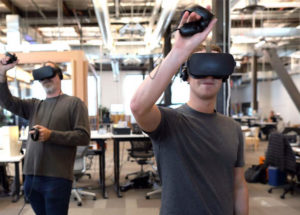Why Social VR Probably Won’t Work the Way Social VR Developers Think
 According to SuperData, sales of high-end VR devices were slow in 2016, with Oculus and Vive selling less than 700,000 total. Oculus recently stopped doing demos in many department stores for lack of interest. And while the mid-range Samsung Gear VR leads the pack with nearly 5 million units, that’s still a fraction of the 100 million or so Samsung smartphones the headset was designed to work with. All this strongly suggests a lack of viral growth or a killer app to drive it.
According to SuperData, sales of high-end VR devices were slow in 2016, with Oculus and Vive selling less than 700,000 total. Oculus recently stopped doing demos in many department stores for lack of interest. And while the mid-range Samsung Gear VR leads the pack with nearly 5 million units, that’s still a fraction of the 100 million or so Samsung smartphones the headset was designed to work with. All this strongly suggests a lack of viral growth or a killer app to drive it.
In the short to medium term, at least, we’re more likely to see social VR embraced by a small contingent of core users, leaving the rest of us behind.
This takes me to a related and even more difficult problem for social VR:
Social VR arrives in the market at a time when broadband and mobile devices have totally remade our model of media consumption. Where it was once appointment-based, in which families and friends would regularly meet in person whenever their favorite TV show was on, we largely use DVRs and streaming services to time shift.
I believe the way forward is thinking about social VR embedded in a larger social experience that transcends VR. Or to put it another way: Once one of your friends puts on a VR headset, what do the rest of you do?
To have any chance at succeeding in a similar fashion, virtual reality developers must devote themselves not just to creating powerful 3D experiences, but also powerful bridges to decades of 2D content, the devices they were built for — and just as key, the people still connected to them.
See the full post here: https://uploadvr.com/social-vr-probably-wont-work-way-social-vr-developers-think/
Pages
- About Philip Lelyveld
- Mark and Addie Lelyveld Biographies
- Presentations and articles
- Tufts Alumni Bio